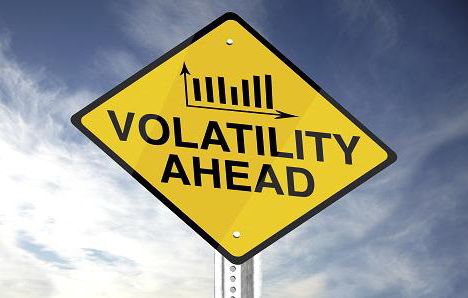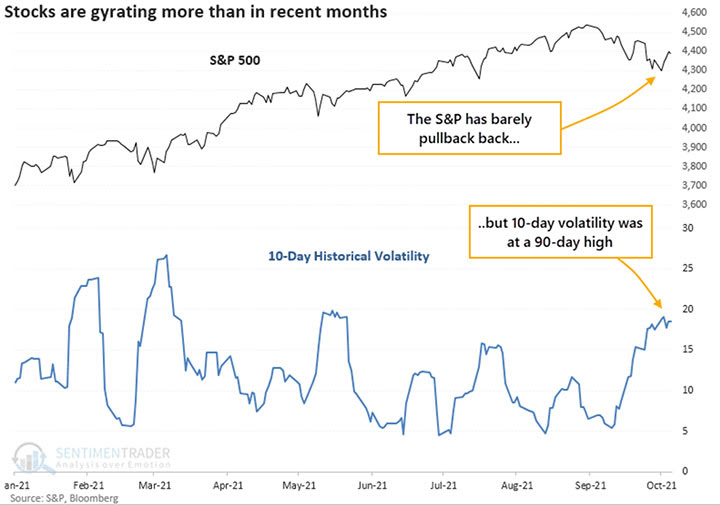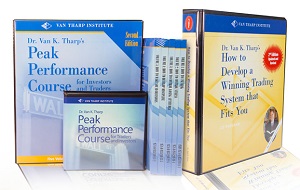
Market Volatility and Systematic Approach By Van Tharp Trading Institute
I keep a close eye on various volatility measures more than anything else in the markets. Sure, price is king, but without a context for how price is moving, I have a difficult time making decisions. For example, a one-dollar move in the utility Southern Company (SO) is a much bigger deal than a one-dollar move in the more volatile tech/real estate company, Zillow (Z).
Currently, even while near a market high, the volatility we see is quite unusual. Textbook technical thinking would tell us that when stocks get volatile in bull markets, it’s time to get worried. But a systematic, data-driven analysis tells us this is not really the case. I love digging in to understand if traditional thinking really holds true. This systematic review process has paid off in my market research…and on the basketball court.
I love to play basketball, and I was a very good shooter in high school. As I’ve added a few years to my age, I find it tougher to compete athletically with the 20-somethings. Ah, but I can still shoot well. So, I find plenty of playing time and I’m now practicing with a team that will compete in the National Senior Olympics in May.
I became an even better shooter just recently by following the advice Van gives all of us —model the best in the business.
What I gained from this was a much better system for shooting, especially for shooting free throws. What I lost was even more important because that thing held the potential to creep in and disrupt what I was trying to do. More about that below.
When I wanted to improve my approach to shooting a basketball, I looked to the best shooter of all time, followed their systematic approach, and as a result, I improved significantly.
Here’s a fun question for you: Without looking up the answer, do you know who is the best professional basketball free throw shooter of all time?
It’s okay if you guessed Steph Curry of the Golden State Warriors. He’s a two-time MVP in the NBA and is widely considered the best shooter of all time. He has an incredible 90.1% free throw accuracy ‒ the best among active players. But that’s only good enough to land him fourth on the all-time list.
Here’s my fun surprise. Professional basketball’s best free throw shooter ever grew up 15 miles from my house and her name is Elena Della Donne.
Della Donne played college basketball for the University of Delaware (the school where I got my MBA) and during her first three years playing for the Chicago Sky in the WNBA, her free throw percentage was 93.8%. So, she’s not only a better free throw shooter than the best men of all-time – she’s a MUCH better free throw shooter altogether.
Number two on the all-time list is Steve Nash with a 90.4% career average. Della Donne’s career number is 3.4% higher. That’s the difference between the number two shooter and the number 35 shooter on the list. That’s domination.
Della Donne breaks down her free throw shooting system into three steps:

- Find the dot (the mid-point of the free throw line) for alignment.
- Create a 90-degree angle with her shooting arm. To kids, she says, “Make an L.”
- Lift & Flick (describing her shooting motion).
Della Donne adds one thing to the end of her routine. She always repeats, “You’re going to make it” to herself just before she shoots.
That step could be the most important part – replacing any emotions or stray thoughts with a positive statement.
I’ve always been a fan of using a systematic approach in the markets. I find that even the most “intuitive” traders I’ve met have at the core of their trading process, a very systematic method for tapping into their intuitive thoughts.
While it’s this systematic approach that brings a great many advantages to our trading, today we’re going to concentrate on eliminating the less-useful emotions from our trading decisions.
System Advantage #1
There are many advantages to understanding your systematic approach to the markets, including efficiency, repeatability, and others. For today, let’s look at what I consider the main advantage of systematic trading – controlling your emotions.
A recent article in the Harvard Business Review by Francesca Gino, a professor at Harvard Business School, holds the very direct title: “Don’t Let Emotions Screw Up Your Decisions.”
Truer words were never spoken for traders.
In the article, Dr. Gino takes readers through two complementary studies where subjects were exposed to processes designed to give them either neutral or angry emotions. Both groups then go through a decision-making process.
In both studies, those that experienced angry emotions made measurably worse decisions than their neutral emotion counterparts.
I’m sure you and I could have guessed the outcome. But this study used the scientific method to confirm what common sense and the title of Dr. Gino’s article tells us – emotions screw up decisions.
Overcoming Emotional Decisions by Using a System
I’ve always believed that, on our trading journey, emotions are nice companions but lousy guides.
This phrase is meant to remind us that life would be pretty darn boring if we never experienced any emotions. But the important distinction when it comes to trading is that we can’t make decisions when in a non-productive emotional state. If we do, we’ll end up with results we don’t like.
That’s where a great system comes to the rescue. It gives us a framework to calmly and coolly evaluate situations and make the right moves.
I’ve often seen traders (especially those newer to the game) become emotional because they treated each individual trade as a “make or break” proposition.
If we treat every single trade as if our self-esteem (or our net worth) depended on the outcome, our thought framework opens the door to bring emotions into the equation. And with many emotions come bad decisions.
The most common way this plays out happens when we’re emotionally invested in a trade and our “need to be right” bias kicks in.
When a trader needs to be right and a trade takes a turn against him or her, instead of getting out at the pre-designed contingency exit, the trader will hold on, hoping for a turnaround. This sets them up to take a much bigger hit than was designed in the original plan.
The flip side of the “need to be right” emotional trade is when a trader has a modest profit in a trade. When the trade starts to move down just a bit, the trader quickly grabs a small profit so they can say they were right even if a much bigger profit was a good probability.
What to do Instead
Tapping into a systematic approach allows us to make decisions in an emotionless way, letting us make decisions without emotion interfering in the process.
Working within a systematic structure also allows us to think about each trade as a smaller part of the bigger whole. If we have a 60 percent chance of a win, according to our system’s history, when the 40 percent scenario plays out, we know that’s just part of the game and we move on to the next profit opportunity.
Dr. Gino wraps up her article by encouraging readers to insert a “pause step” between times emotions run high and those instances when we have to make an important or complex decision. Van has given us many great tools for this. His work on achieving the proper mental state for trading (or researching, etc.) is the best I’ve seen.
I’ve gone through Van’s Peak Performance Home Study Course (on sale now) in its entirety multiple times. Every time, I learn something new. And, every time, important, valuable thought processes and habits are reinforced. My favorite mental state for trading is a combination of relaxed alertness combined with resourcefulness.
Like Elena Della Donne’s recitation, “I’m going to make it” before shooting a free throw, I use an anchoring technique to clear my mind and get me ready to trade or research.
Let me know what your preferred mental state is for trading or investing. I always enjoy hearing from you. My email address is below.
Now, back to today’s oddly volatile markets.
The S&P has been in its longest pullback in a year since the September 2nd high. This has many people concerned that this could be THE top. Bearish sentiment among retail traders recently hit 54% among retail investors according to an Allianz survey.
As we look at heightened volatility, remember what we discussed at the top of the article – textbook technical thinking would tell us that when stocks get volatile in bull markets, it’s time to get worried. And 10-day volatility has recently hit a 90-day high, as we can see here:
The classic view would be that this should be an alarm bell for traders. But instead of trusting theory, let’s look at what has actually happened. The folks at Sentimentrader.com looked back to 1928 for instances when the S&P was within 5% of all-time highs and 10-day volatility hit multi-month highs. Over the next six months, the index rose 91% of the time out of 22 occurrences.
So, despite longer-term and very real concerns I have over Fed tapering, inflation, supply chain, and other issues, the data is not supporting a bullish posture just yet.
Van Tharp Trading Institute Courses


